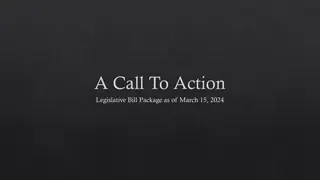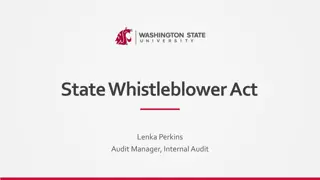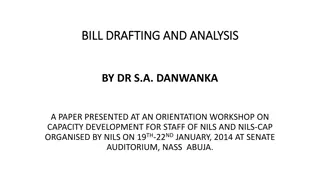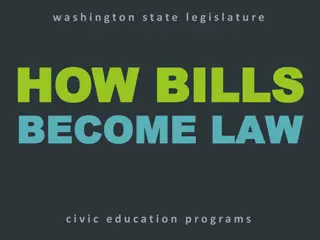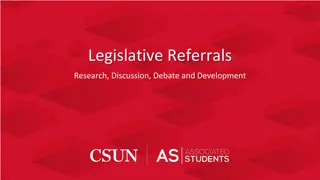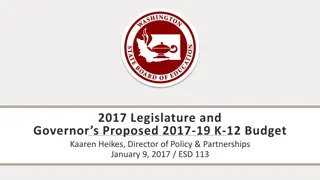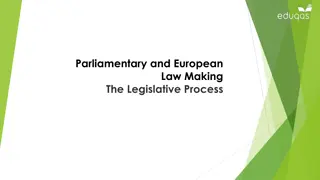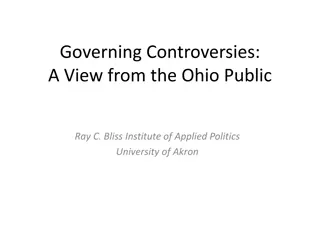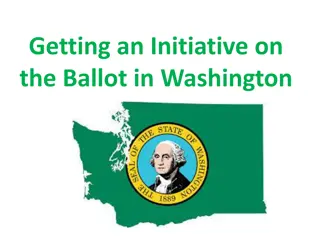The Legislative Process in Washington State - How a Bill Becomes Law
In Washington State, the process of how a bill becomes law is detailed through various steps starting with the drafting of the bill, introduction in either the House or Senate, referral to committee, hearings, marking up of the bill, and final passage. The structure of the State Legislature plays a crucial role in this process, involving various committees and legislators who evaluate the proposed legislation before it can become law.
Download Presentation

Please find below an Image/Link to download the presentation.
The content on the website is provided AS IS for your information and personal use only. It may not be sold, licensed, or shared on other websites without obtaining consent from the author. Download presentation by click this link. If you encounter any issues during the download, it is possible that the publisher has removed the file from their server.
E N D
Presentation Transcript
How a Bill Becomes a Law at the State Level Feat. Washington State Legislature
First of all...how is the State Legislature structured?
You can find a more detailed overview of the process here.
Any member of the Legislature either from the Senate or the House or Representatives who has an idea for a law can draft a bill. These ideas come from the Congress members themselves or from everyday citizens and advocacy groups. The primary Congress member supporting the bill is called the "sponsor". The other members who support the bill are called "co- sponsors". Step 1: The Bill is drafted
Step 2: The bill is introduced Once the bill is drafted, it must be introduced. If a Representative is the sponsor, the bill is introduced in the House. If a Senator is the sponsor, the bill is introduced in the Senate. Once a bill is introduced, it can be found on https://app.leg.wa.gov/billinfo/ Sometimes an identical companion bill is introduced in the other house, just to speed up the process a bit. So that s why you may see a bill referred to as SB0000/HB0000
Step 3: The bill goes to committee As soon as a bill is introduced, it is referred to a committee. Both the House and Senate have various committees composed of legislators who are particularly interested in different topics. When a bill is in the hands of the committee, it is carefully examined and its chances of passage are determined. The committee may even choose to hold hearings to better understand the implications of the bill. Hearings allow the views of experts, other public officials and supporters, and opponents of the legislation to be put on the record. If the committee does not act on a bill, the bill is considered
Committe es Joint Legislative Committees, Work Groups, Task Forces House Standing Committees Senate Standing Committees
When the hearings and subcommittee review are completed, the committee will meet to "mark up" the bill. They make changes and amendments. Step 4: Committee mark up of the bill The committee report on the passed bill is read in open session of the House or Senate, which is called the "floor"
Step 5: The bill goes to the Rules Committee The bill is then referred to the Rules Committee. The Rules Committee can either place the bill on the second reading calendar for debate before the entire body, placed on the suspension calendar for non-controversial bills, or take no action. The Rules Committee is where leadership exercises the most control over the process. The Rules Committee is made up of members from both parties. Each member on the committee gets to select two or three bills that will move on to the next step in the process. Which bills a member selects could be the result of a party caucus, or another member approaching that member, or a piece of legislation about which the member feels strongly.
Step 6: The bill goes to second reading It is on second reading that the chamber discusses the merits of the legislation. It is here, too, where members can offer amendments to the bill. Most bills that get this far get their second reading in the couple of weeks following the committee cut-off. If a bill has been amended in committee or on the floor in the first house, it is ordered engrossed. Engrossing a bill means incorporating the amendments into the body of the bill so that the second house gets one document.
Third reading is where the roll call vote on final passage is taken. If the bill finally passes, it continues in the process. If the bill fails on final passage, it goes no further. Step 7: Then there is a THIRD reading (and you thought your history readings were rough!)
Step 8: Do it all again! After passing one house, the bill goes through the same procedure in the other house. This is where companion bills are helpful. At this point the other house may have put the bill through steps 1-6 already.
Step 9: The bill must be approved by both houses This second house may approve the bill as received, reject it, ignore it or change it. If amendments are made in the other house, the first house must approve the changes. They may form a conference committee to resolve or reconcile the differences between the House and Senate versions of a bill. If the conference committee is unable to reach an agreement, the bill dies. If an agreement is reached, the committee members prepare a conference report with recommendations for the final bill. When the bill is accepted in both houses, it is signed by the respective leaders and sent to the governor.
Step 10: The bill becomes a law!....or not The governor signs the bill into law or may veto all or part of it. If the governor fails to act on the bill, it may become law without a signature. If the Governor vetoes part or all of it, the Legislature may vote to override the veto. From the Governor's desk, bills go to the Secretary of State who assigns a session law chapter number.
Step 11: Going ghost! The Legislature works within the framework of a two-year cycle. There will be a least two regular sessions, a "long" session (odd years) and a "short" (even years) session. There could also be any number of special sessions. Therefore, just because a bill did not make it all the way through during the regular session in the odd-numbered year does not mean it is "dead." "Carryover" bills can be taken up again in subsequent sessions during the biennium. At the end of the session, all bills in the second house are returned to the first house and is reintroduced and retained in their
Sine Die :) Note: State Government essentially parallels the Federal Government!




